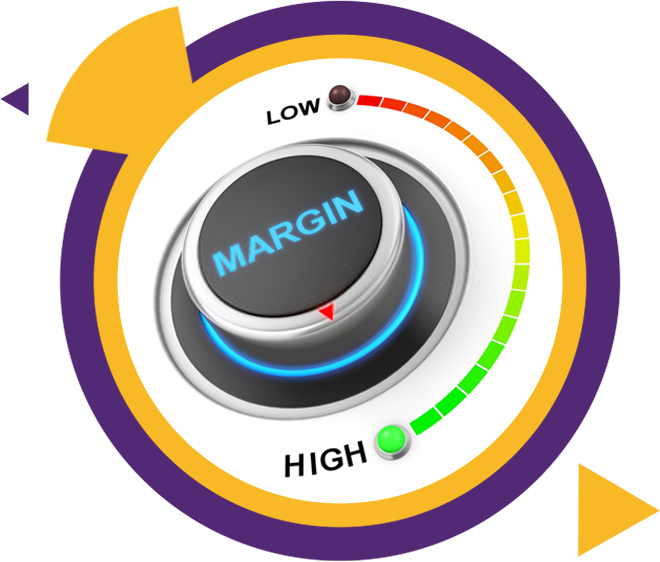Forex Leverage & Margin
All traders use borrowed funds in one way or another to increase the potential return on investment. Investors often use margin accounts when they want to invest in stocks or currencies, using money “borrowed” from a broker to control a large position starting with minimal capital.
So they can risk a relatively small deposit but buy a lot, which otherwise would not be affordable for them. The margin on Forex is an important topic for novice traders. Therefore, we propose to delve into Forex and find out everything in detail.

What is Forex margin in simple words?
If you do not go into details, Forex margin is simply the extent of buying power that a broker provides you against your deposit.
Margin trading allows traders to increase their initial position size. But we must not forget that this is a double-edged sword, as it increases both profits and losses. If the price forecast goes wrong, the Forex account will get empty in the blink of an eye because we are trading a huge volume.
Why is margin important for Forex traders?
Traders should pay attention to the margin in Forex because this tells them if they have adequate funds to open further positions or not.
Better understanding of margin is really vital for traders while getting into leveraged Forex trading. It is important to comprehend that trading on margin has high potential for both profit and loss. Hence, traders should familiarize themselves with the margin and terms associated with it like margin call, margin level, etc.
What is the margin level?
Margin level is the percentage of your deposited amount that is already used for trading. It will help you see how much money is used and how much is left for further trading.
What is free margin in Forex?
Free margin is the available buying power for trading. Free margin is calculated as subtracting the used margin from total margin.
Free margin example
Suppose I have $8000 on my balance. In an open trade, $2500 is borrowed. Free margin is $8000 – $2500 = $5500. If you try to open a deal for which there is not enough free money, the order will be automatically canceled.
How are leverage and margin related?
Leverage and margin are two sides of the same coin. If the margin is the minimum amount required to place a leveraged trade, then leverage is a tool that allows a trader to move large lots that would not be affordable for him at the cost of 1: 1. Leverage is the “increased trading power” available when using a Forex margin account. It is a virtual “placeholder” for the difference between what we have and what we want to operate on. Leverage is often expressed in an “X: 1” format.
So, I want to trade a standard lot of USD / JPY without margin. I need $100,000 on my account. But if the margin requirement is only 1%, I only need $1000 on the deposit. The leverage, in this case, is 100: 1.
What is a margin call, and how to avoid it?
A margin call is what happens when a trader runs out of free margin. If there is less amount deposited than required under the terms of leverage, open trades in Forex are automatically closed. This is a mechanism that limits the loss and traders do not lose more than their deposited amount. Traders can avoid margin call if they use the margin wisely. They should limit their position size according to their account size.
Calculating the maximum lot for margin trading
The standard Forex lot size is 100,000 currency units. With a 100: 1 leverage, every $1000 deposit in a trading account gives you buying power of $100,000. The broker allows the traders to dispose of this hundred thousand, while there is a real thousand on the deposit.
For example, if we will buy 10,000 currency units at 1.26484 with a leverage of 400: 1, we will get a little more than $ 31 of the required margin. This is the very minimum “collateral” for opening a trade in Forex.
Example of margin trading
Let’s say a trader opens an account with a broker with a leverage of 1: 100. He decides to trade the EUR / USD currency pair; that is, he buys in euros for the US dollar. The price is 1.1000, and the standard lot is € 100,000. In normal trading, he would have to deposit 100,000 into his account to open a trade. But trading with a leverage of 1: 100, he only deposits $ 1000 into his account.
Forecasting the rise or fall of the price, he opens a long or short trade. If the price goes right, the trader will make a profit. If not, the drawdown may exceed your deposit. The deal will close, the trader will lose money.
Conclusion
Of course, margin trading is a useful tool for those looking to trade Forex with limited start-up capital. When used correctly, leveraged trading promotes rapid profit growth and provides more room for portfolio diversification.
This trading method can also exacerbate losses and involve additional risks. Thus, we conclude that it is quite hard to enter the real market without knowing the features of Forex.
The risk of losing all the money is too high. As for cryptocurrencies and other volatile instruments, such as metals, only experienced traders who generally have a good level and successful statistics can go in here.
By the way, it will be interesting to know if you like Forex, if you like to trade with leveraged funds, and what is your favorite leverage.

 About us
About us  Why us
Why us  Information Services
Information Services  Trading Products
Trading Products  Trading Accounts
Trading Accounts  Trading Platform
Trading Platform  Education
Education  Contact us
Contact us  FAQs
FAQs





